Are you looking for creative ways to decorate a kindergarten classroom? If so, you’ve come to the right place. Decorate a kindergarten classroom is an important task that requires careful planning and consideration.
Decorate a kindergarten classroom, from color schemes and wall decor to furniture placement and interactive learning corners, and we’ll cover it all. Create a welcoming environment that fosters their creativity and love of learning.
This article will provide practical tips and ideas to help you turn your kindergarten classroom into a vibrant and engaging space. Whether you’re a teacher or a parent, our suggestions will help create a well-designed classroom that encourages participation and engagement.
Why is it Important to Decorate a Kindergarten Classroom?
The importance of decorate a kindergarten classroom cannot be understated. Children spend significant time during crucial developmental years in this setting. A well-decorated classroom can:

- Enhance Learning and Engagement:
Children are naturally visual learners. A visually stimulating classroom can enhance their learning and keep them engaged. Decorations like colorful charts, maps, and posters can be educational tools, making learning more interactive and fun.
- Foster a Sense of Belonging and Comfort:
Young children need a safe and comfortable environment to thrive, and a well-decorated kindergarten classroom plan can make a classroom feel warm and secure, helping children settle in faster and feel a sense of belonging.
- Stimulate Creativity and Imagination:
A creatively decorated classroom can ignite a child’s imagination, an essential aspect of cognitive development. Spaces encouraging creativity can lead to innovative thinking and problem-solving skills in young children.

- Aid in Behavioral Management:
A well-organized and neatly decorated classroom can indirectly aid in better behavioral management. Children in a structured and visually appealing environment will likely be more focused and less prone to disruptive behavior.
- Promote Cognitive and Emotional Development:
Different colors, textures, and layouts can stimulate cognitive and emotional development. For instance, blue hues can be calming, while bright colors stimulate energy and happiness.
Planning Kindergarten Classroom Layout and Design
Planning the layout and design of your kindergarten classroom is a task that requires careful consideration before decorate a kindergarten classroom. There’s no way you can decorate a kindergarten classroom if you don’t have a good classroom layout in place, so here’s a step-by-step guide to help you plan effectively:
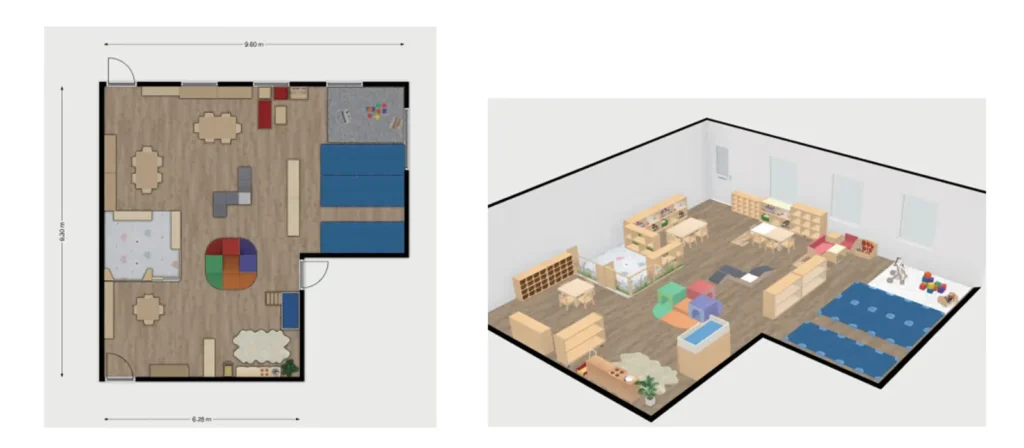
- Understand the Space: Begin by assessing the size and shape of the classroom. Consider factors like natural lighting, ventilation, and acoustics. These elements are fundamental to creating a comfortable learning environment.
- Zone Creation: Decorate a Kindergarten Classroom Area Creation: divide the classroom into different areas based on activities – reading corner, arts and crafts area, nap area and play area. Each area should serve a specific purpose and be designed accordingly.
- Furniture Selection: Decorate a kindergarten classroom requires choosing furniture that is child-sized, safe and comfortable. At Xiha Montessori, we understand the importance of furniture that is both functional and conducive to learning. Our range of kindergarten furniture is designed to meet these needs.
- Flexibility and Mobility: Having flexible and mobile furniture makes it easy to rearrange the decorate a kindergarten classroom, changing the structure of the classroom to accommodate different activities and learning styles.
- Incorporating Technology: Plan to integrate technology to complement the classroom’s overall design. This could include areas for interactive whiteboards, computers, or tablets.
- Color Scheme: Choose a color scheme that is harmonious and conducive to learning. While bright colors can be stimulating, it’s important to balance them with softer, calming shades to create a harmonious environment.
- Storage Solutions: Efficient storage solutions are crucial in maintaining an organized and clutter-free space. Consider using open shelves, labeled bins, and closets to store educational materials and children’s belongings.
- Incorporate Nature: Bringing elements of nature into the classroom can have a calming effect and connect children with the natural world. This can be achieved through indoor plants, natural light, or nature-themed decorations.
Choosing a Theme for Your Kindergarten Classroom
Choosing a classroom theme for your classroom is a fun and essential part of the process of decorate a kindergarten classroom. A theme can provide a cohesive look and feel, making the classroom a more attractive and enjoyable space. Here’s how to choose the right theme:
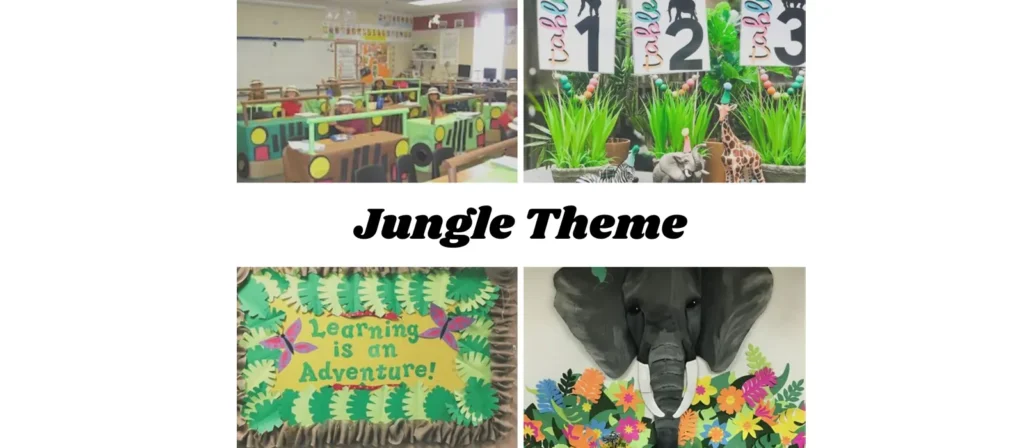
- Age Appropriateness: Ensure the theme is suitable for the age group of the children. It should be engaging, understandable, and relatable to young learners.
- Educational Value: Choose a theme that offers educational value. Themes related to nature, seasons, animals, space, or under the sea can be fun and informative, introducing new concepts and vocabulary.
- Cultural Sensitivity and Inclusivity: Select a theme that promotes inclusivity and cultural awareness. Avoid stereotypes and ensure the theme is respectful and representative of diverse backgrounds.
- Flexibility for Adaptation: A good theme should allow for adaptations and changes throughout the year. This keeps the classroom environment fresh and adaptable to various educational topics.
- Sustainability: When implementing a theme, consider the materials’ sustainability. Opt for reusable and environmentally friendly decoration materials as much as possible.
- Thematic Learning Materials: Incorporate learning materials that align with the theme. For instance, if you choose a space theme, use star charts, planet models, and space-themed storybooks as part of the decor and educational materials.
Choosing a theme is not just about decoration; it’s about creating an immersive learning experience for the children. A well-chosen theme can transform a classroom into a vibrant and captivating learning space.
Tips for Decorating A Kindergarten Classroom
Identifying the challenges in decorate a kindergarten classroom is key. The goal is to create an environment that is safe, stimulating, and conducive to learning. However, finding the right balance between functional and playful can be tough. This means choosing the right decorations, furniture, and classroom layout that cater to the developmental needs of young children.
1. Essential Decorations for a Kindergarten Classroom
Regarding kindergarten classrooms, decorating isn’t just for show; it’s an essential part of the learning environment. Basic décor should be both functional and attractive.

Bulletin Board
Bulletin boards are the centerpiece of classroom communication. They are dynamic platforms for displaying educational themes, celebrating student achievement, and showcasing lesson plans. A well-organized bulletin board can be a central point for students to engage with the curriculum and each other.
Displaying Student Work
Displaying student work is a powerful tool for building self-esteem and a sense of community. When children see their work celebrated, it encourages a sense of pride and ownership in the learning process.
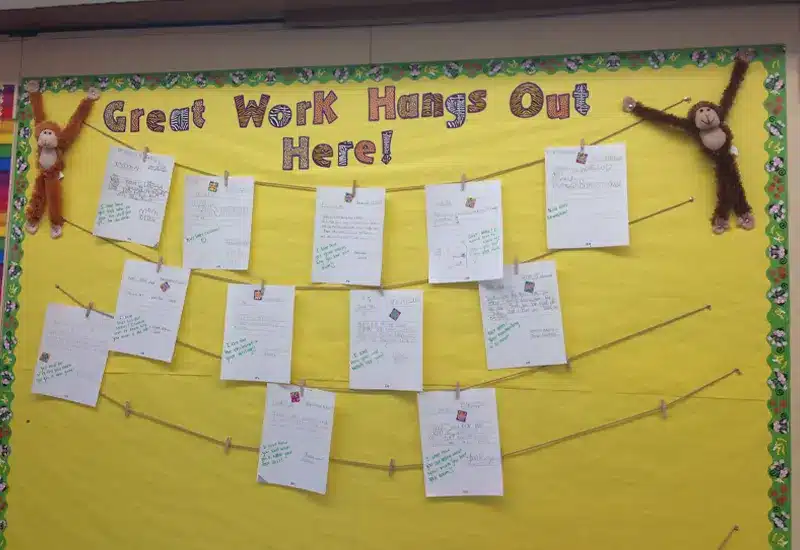
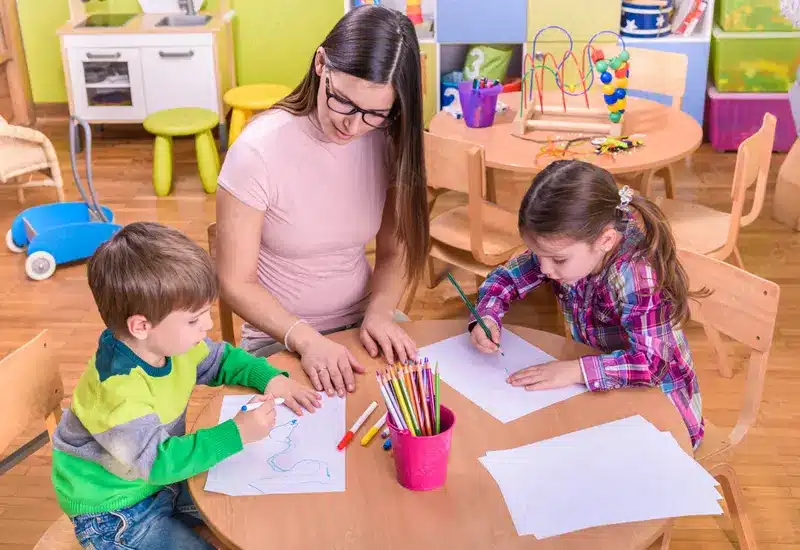
Student Workstations
Student workstations foster independence and focus. Workstations can be as simple as a table and chairs or more complex setups with storage and organizational materials. These spaces should accommodate a variety of activities, from individual work to group projects.
Wall Decorations
Wall decorations play a dual role: beautifying the classroom and serving as educational tools. Maps, alphabets, number charts, and thematic art not only enliven the walls but also provide visual learning aids for students.
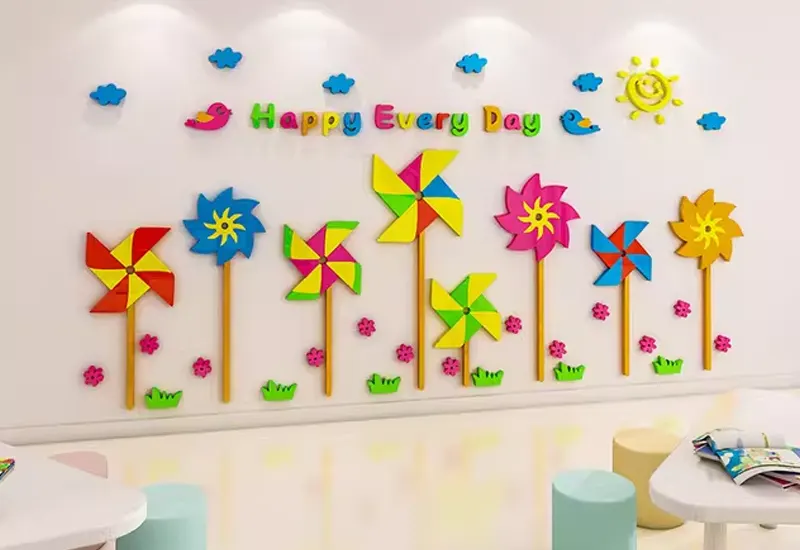
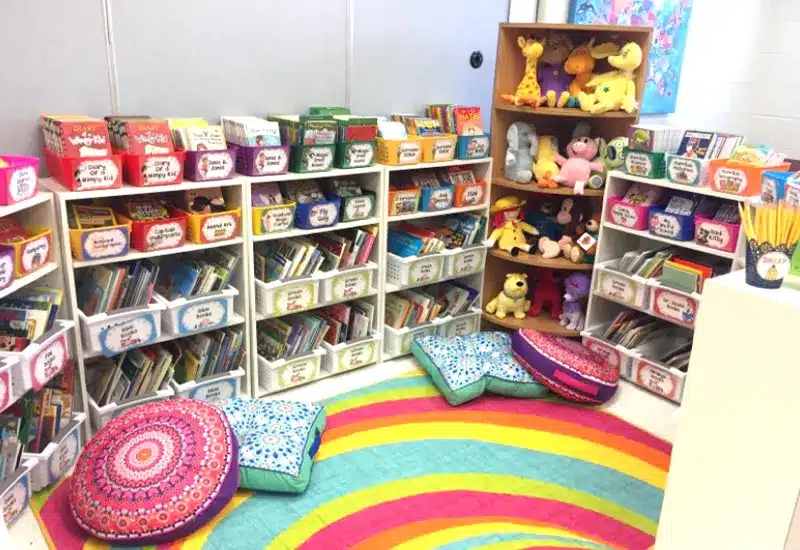
Kindergarten Classroom Library
A classroom library is a nurturing corner that promotes literacy and a love for reading. It should be inviting and well-stocked with books appropriate for the age group. Comfortable seating and accessible bookshelves encourage students to explore the world of literature.
Kindergarten Classroom Map
A classroom map is an educational tool that broadens students’ horizons. It sparks curiosity about different countries, cultures, and geographical concepts. Interactive maps can be a fun and engaging way to introduce basic geography to young learners.
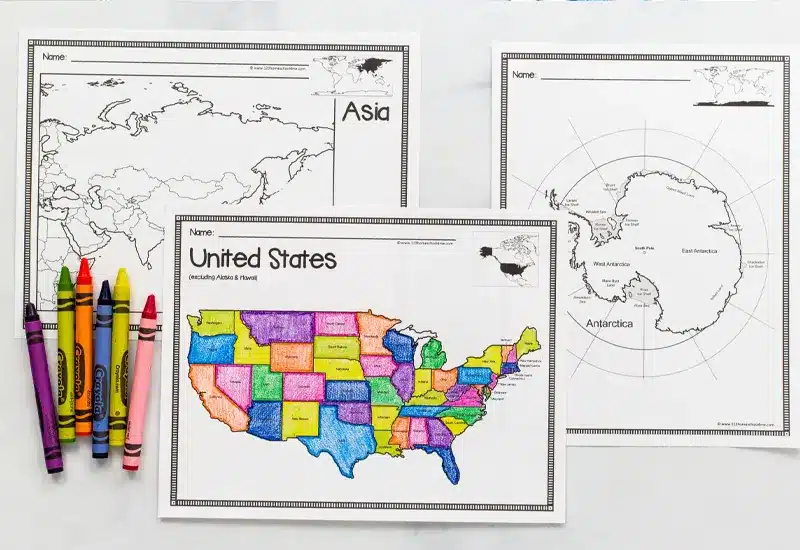

Carpets and Flooring
Carpets and flooring in a kindergarten classroom serve multiple purposes. They provide a safe, comfortable area for children to sit, play, and learn. Educational designs on carpets can also be a subtle yet effective learning tool, such as alphabet or number prints.
Kindergarten Furniture
Furniture in a kindergarten classroom should be safe, durable, and appropriately sized for young children. The right furniture supports various classroom activities, from quiet reading time to group activities, and should be flexible to accommodate different learning styles.


Curtains & Drapes
Curtains and drapes contribute to the aesthetic of the classroom while serving practical functions. They help control the amount of natural light in the room and can be used to create a cozy and focused learning environment.
Classroom Supplies
Classroom supplies are the tools of learning and creativity. From pencils and paper to art supplies and educational games, these materials support a wide range of activities and learning styles in the classroom.
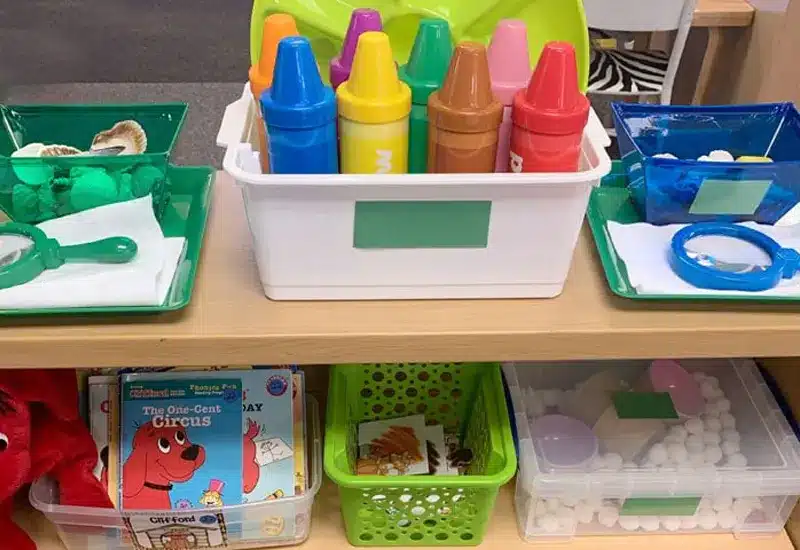

Storage Cubicles
Storage cubicles help maintain organization and cleanliness in the classroom. They provide a place for students to store their belongings and teachers to organize materials, contributing to an orderly learning environment.
Baskets
Baskets are versatile storage solutions that can be used for organizing toys, books, and learning materials. They are easily accessible for children and can be moved around the classroom as needed.


Plants
Introducing plants into the classroom brings a bit of nature indoors. They improve air quality and teach children about plant care and the natural world.
Classroom Rules
Establishing clear and visible classroom rules is fundamental to creating a structured learning environment. Rules should be simple, positive, and displayed at a child’s eye level. Use colorful posters with illustrations to make them easily understandable for young children.
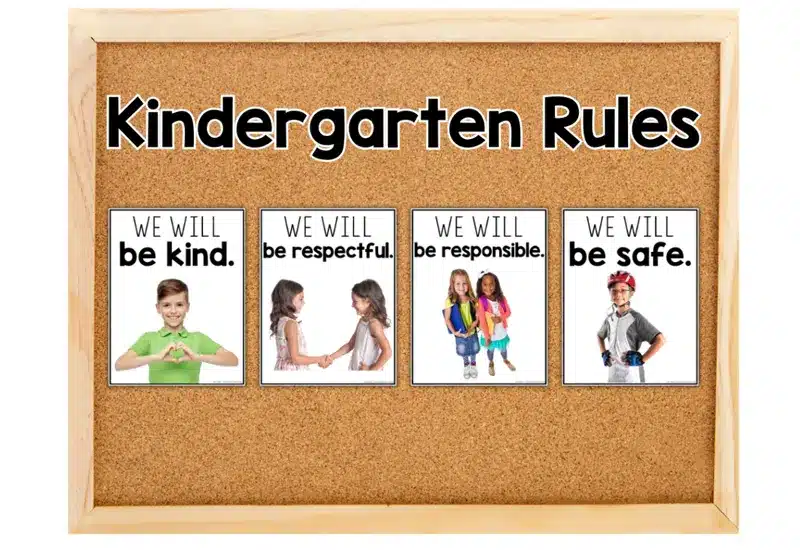

Lighting
Natural light is the best choice because it improves mood and concentration. If natural light is limited, use warm, adjustable lighting to create a comfortable and inviting atmosphere. Avoid harsh fluorescent lighting, which can strain your child’s eyes.
Wallpaper
Wallpaper can significantly enhance the classroom’s aesthetic appeal. Choose bright, cheerful patterns that stimulate learning without overwhelming the space. Removable wallpaper is a great option for easy updates and changes.


Calendar Wall
A calendar wall is an excellent tool for teaching children about time, days of the week, and months of the year. Use a large, interactive calendar that students can help update daily.
Chalkboard or Whiteboard
A chalkboard or whiteboard is an indispensable tool in any classroom. It provides a space for lessons, drawings, and interactive activities. Ensure that it is placed at a height accessible to children. Using colorful chalk or markers can make lessons more engaging.

Each decorative element in a kindergarten classroom uniquely contributes to the learning environment. From bulletin boards to wallpapers, these elements work together to create a space that is not only visually appealing but also conducive to learning, creativity, and growth.
2. DIY Decoration Ideas for a Kindergarten Classroom
DIY decorations add a personal touch to the classroom and can be a fun project for teachers and students. One idea is to create a seasonal theme that changes throughout the year. For instance, a fall theme could include leaves and pumpkins made by the children using paper and paint. This not only decorates the classroom but also teaches children about seasons and holidays.
Another DIY idea is to create a classroom tree. This can be a large tree drawn or painted on a wall, with branches extending out. Children can add leaves, birds, and other elements to the tree, which can change according to the season or classroom topics. This creates a dynamic and interactive element in the classroom.

Classroom curtains can also be a DIY project. The children can transform Simple, plain curtains using fabric paints or markers. They can add their handprints, drawings, or patterns, making the curtains a unique and personal part of the classroom.
3. Organizing and Storage Solutions for a Kindergarten Classroom
In kindergarten classrooms, organization and storage help maintain clearly defined areas for different activities and corresponding materials. Open shelving units with labeled bins are ideal for storing toys, art supplies, and educational materials. Not only does this keep things tidy, but it makes it easy for children to find and store items.
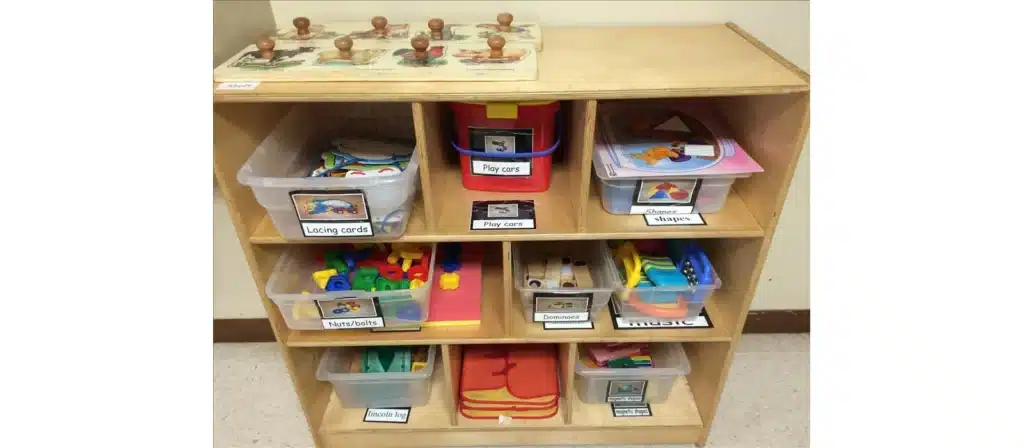
Mobile storage units are very effective, especially in smaller classrooms. These can be wheeled to where needed, making the space more flexible. For example, carts with art supplies can be moved to tables during craft time and stored away when unused.
Using vertical space, wall-mounted shelves or hanging organizers can store items without taking up floor space, which is especially useful for storing teachers’ materials away from children.
4. Incorporating Multicultural Elements in Kindergarten Classroom Decor
Decorating a kindergarten classroom can incorporate multicultural elements. It helps children understand and appreciate different cultures from an early age. One way to do this is through a “world corner”, where decorations, toys and books from different cultures are displayed. This may include traditional clothing, musical instruments and flags.
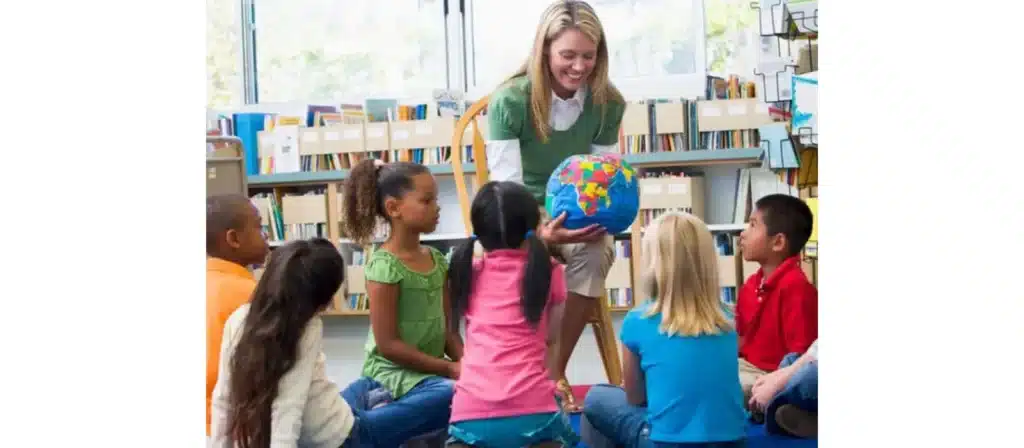
Art is another powerful tool for incorporating multicultural elements. Displaying art from different cultures or having children create art inspired by different traditions can be educational and decorative. This may involve Japanese origami, indigenous dot painting, or African mask making.
5. Classroom Decorating Welcome Signs
Welcome signs are the first thing children and parents see when they enter the classroom. They set the tone for a warm and inviting learning environment. Use bright colors and fun fonts, and include the children’s names to create a sense of belonging. A well-designed welcome sign can excite and welcome students from the first day.
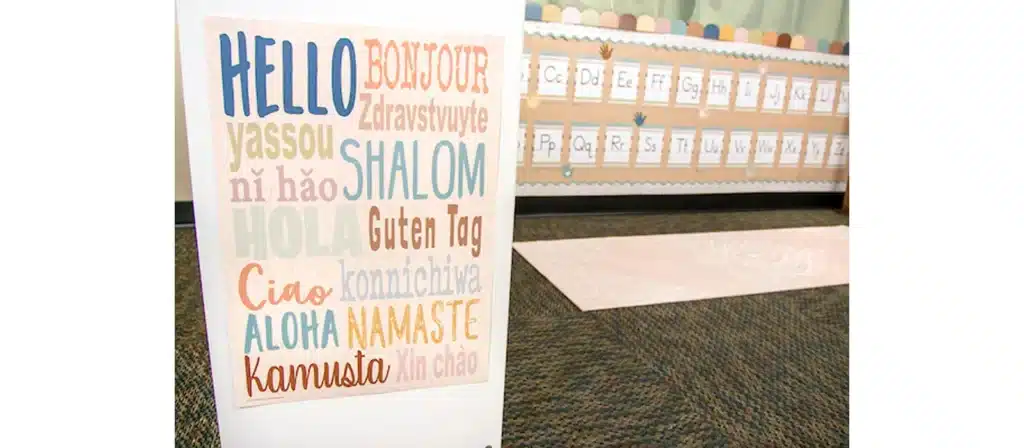
Consider incorporating themes or seasonal elements into your welcome signs to keep them fresh and exciting. For example, in the fall, you might use autumn leaves and pumpkins, while in the spring, you could incorporate flowers and butterflies. These small changes can make a big difference in how welcoming the classroom feels throughout the year.
Another idea is to make the welcome sign interactive. Allow students to add their decorations or drawings to the sign. This personalizes the space and encourages creativity and a sense of ownership among the students.
6. Keep the Colors Vibrant
Bright, cheerful colors can stimulate learning and keep children engaged. Use a mix of primary colors and pastels to create a balanced and inviting atmosphere. Paint the walls in light, soothing colors and use vibrant accents in furniture, rugs, and decorations. This approach ensures the classroom is lively without being overwhelming.

Incorporate different color schemes in various areas of the classroom. For example, use calm, cool colors like blues and greens in reading areas to create a serene environment and vibrant colors like reds and yellows in play areas to energize and excite students.
Additionally, consider using color-coded zones within the classroom. Each area can be designated by a specific color, making it easier for children to understand where different activities occur. This can help with organization and classroom management.
7. Creative Doors
A creative door can be a fun and imaginative addition to the classroom. Decorate the door with themes like a castle entrance, a space shuttle, or a jungle gateway. This makes the entrance more exciting and sets a creative tone for the classroom. Engaging themes can spark imagination and curiosity in children.
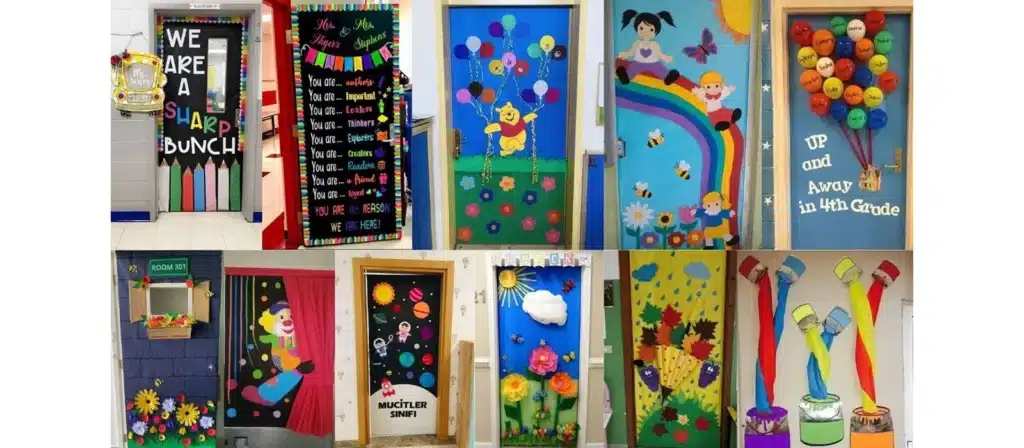
Change the door decoration periodically to keep things fresh and exciting. You can align the themes with the current curriculum or the seasons, making the entrance a dynamic part of the learning environment.
8. Use a Play Mat as a Rug
Playmats are versatile and practical additions to any kindergarten classroom. They can serve as rugs, providing a soft area for children to sit and play. Choose mats with educational designs, such as alphabets, numbers, or maps. This not only adds to the decor but also creates additional learning opportunities.
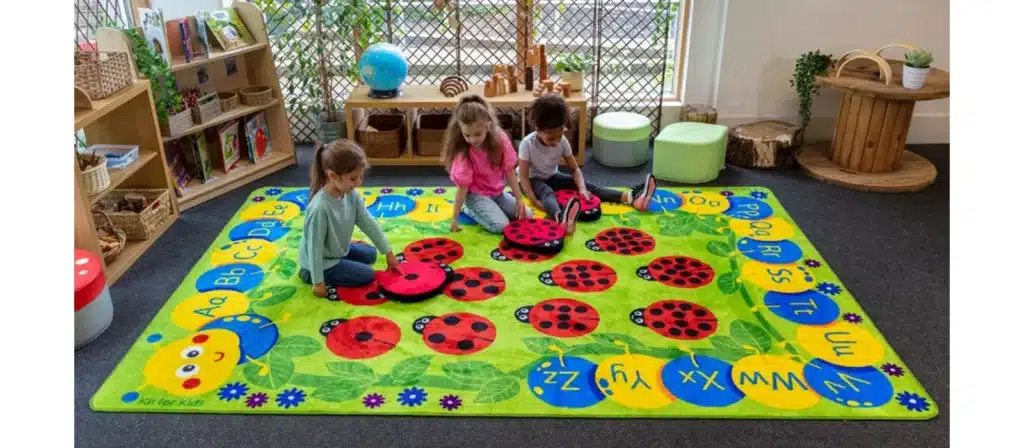
Play mats come in various materials and designs. Foam mats are great for comfort and safety, while fabric mats can add a touch of coziness. Ensure the mats are easy to clean and durable enough to withstand daily use.
Integrate the play mats into different classroom zones. For instance, a mat with a cityscape design in the block area can inspire imaginative play, or a mat with numbers and letters in the learning corner can support educational activities.
9. Taking Pictures on the First Day

Capturing memories on the first day can be a wonderful tradition. Set up a photo booth with props and a backdrop related to the classroom theme. Taking pictures of each child on their first day can create a sense of excitement and provide lasting memories for the students and their families. These photos can be displayed throughout the year, reminding everyone of the special day.
Consider creating a “First Day of School” photo wall where you display the pictures for the first month. This decorates the classroom and helps children and parents feel a sense of community and belonging.
10. What Role Does Technology Play in Classroom Decoration
Technology has become an integral part of education, extending to classroom décor. Interactive whiteboards or smartboards can be used for teaching and as dynamic decoration. They can display educational games, art, or topics relevant to the current curriculum.
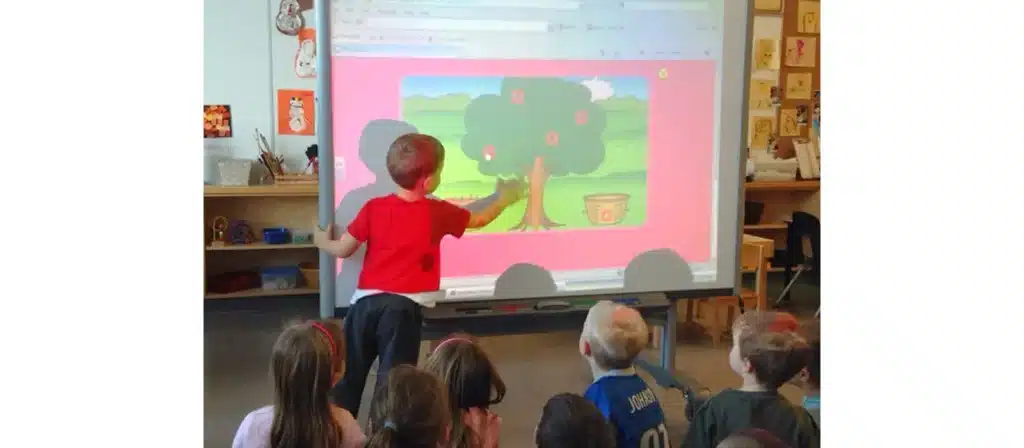
Another aspect of decorative technology is the use of educational apps on tablets. These can be part of a technology corner where children can use interactive learning apps. This is not only a decorative element but also a learning tool.
Finally, technology can be used to create sensory experiences in the classroom. This could include sound systems that play music, ambient sounds, or even projectors that display calming or educational visuals on the walls or ceiling.
Decorate a Kindergarten Classroom: Notes
When considering classroom decorating ideas, it’s easy to get caught up in some of the online examples of decorate a kindergarten classroom and what we see on social media. But not just because a classroom looks good is the right decorating style for you. You should consider the needs of your students!
1. Don’t Overcrowd the Room
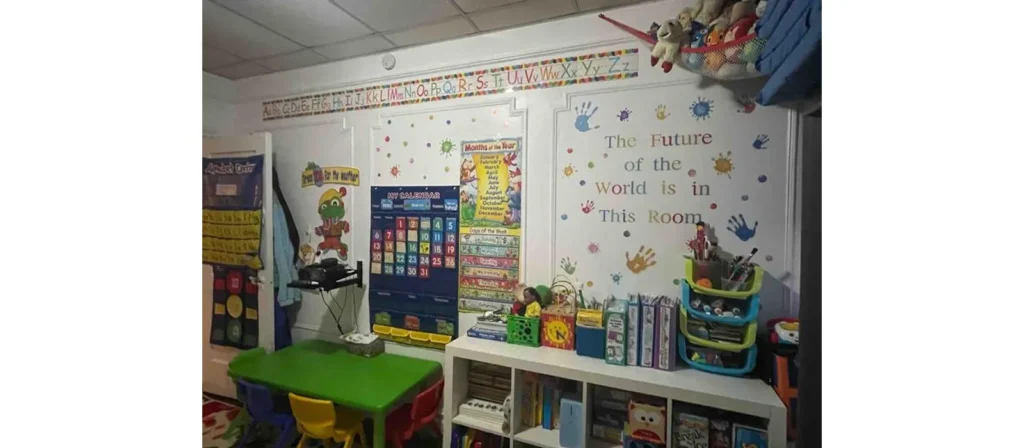
A common flaw in classroom décor is overcrowded spaces. While filling every nook and cranny with educational materials and decorations is tempting, an overly cluttered room can overwhelm young children. It’s important to create a clean, organized space that allows freedom of movement and easy access to learning materials. Overcrowding can also distract children from the main focus of the classroom. Carefully selected decorations with a purpose can be more effective in keeping children’s attention and reducing sensory overload.
2. Not Decorated for You
Remember, classrooms are for children, not adults. Decorate a kindergarten classroom should cater to their interests, developmental stages and learning needs. Avoid using materials that appeal more to adults than children. Themes and decorations should be relevant to young learners, using characters, themes, and colors that are interesting and familiar to them.
3. Make Room for Students
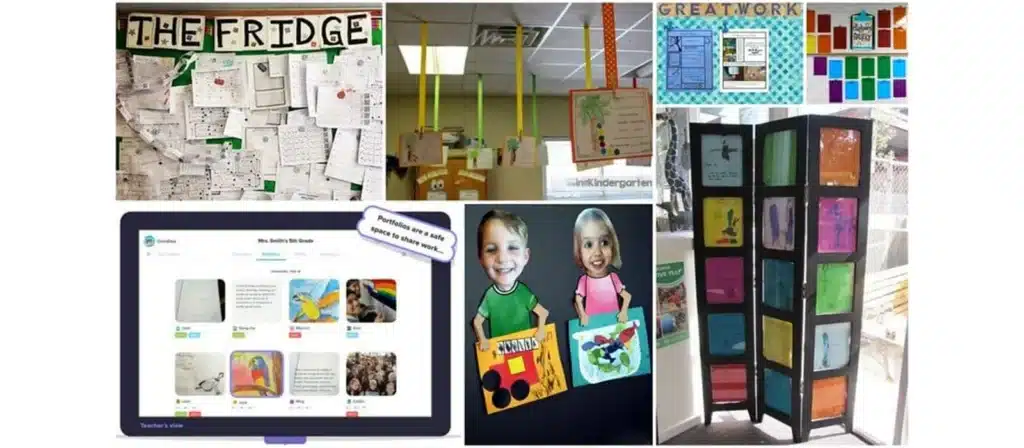
The classroom should be a reflection of the students. Allocate space to display student work, photos, and projects. This personalizes the space and gives children a sense of pride and ownership. Having a designated area where students can display their creativity and academic accomplishments encourages them to participate actively in the classroom environment. In addition, engaging students in the process of decorate a kindergarten classroom can be a fun activity that fosters a sense of community and belonging. It is also an opportunity to learn about organization, design and teamwork.
4. Take it Easy on Yourself
Decorating a classroom doesn’t have to be a daunting task. Start small and add decorations gradually over time. Not only does this approach make it manageable for the teacher, but it also allows the classroom to evolve according to the interests and needs of the students. It is also important to remember that not every decoration needs to be perfect or professionally made. Handmade and student-created decorations can add a unique and personal touch to a room.
When decorate a kindergarten classroom, the focus should be on creating a space that is comfortable, functional, and reflective of the children who use it. By avoiding overcrowding, tailoring decorations to the students’ level, making room for student involvement, and taking a gradual and simple approach to decorating, educators can create an environment that is both educational and welcoming.
Safety Considerations When Decorate a Kindergarten Classroom
Safety is the most crucial aspect when decorate a kindergarten classroom. Here are some key safety considerations:

- Non-toxic Materials: Use only non-toxic, child-safe materials for decorations and furniture. This includes avoiding lead-based paints and ensuring all materials are free from harmful chemicals.
- Secure Fixtures: Ensure all decorations, shelves and furniture are securely fastened to prevent tipping or accidents. If rugs are used, ensure they are secured to the floor to prevent tripping. Check these fixtures regularly to ensure they remain secure.
- Age-Appropriate Decor: Choose decor that is appropriate for the age group. Avoid small objects that could be choking hazards and ensure all elements suit young children.
- Fire Safety: Adhere to fire safety regulations when decorating. This includes using flame-retardant materials and ensuring that exits are marked and unobstructed.
- Emergency Preparedness: Incorporate elements that aid in emergency preparedness, such as evacuation maps and emergency contact information displayed in an accessible and visible area.
Ensuring the safety of the children is our foremost responsibility when decorating a kindergarten classroom. A safe environment is a prerequisite for effective learning and development.
Collaborating with Students and Parents in the Decoration Process
Involving students and parents in the decoration process can be a rewarding experience. This collaborative approach enhances the classroom’s aesthetic appeal and fosters a sense of community. Start by organizing a classroom decoration day where parents and children can contribute.
Parents are encouraged to share items that can be used for decoration, such as books, educational toys or artifacts. This enriches the classroom environment and brings a different perspective and experience. Parental involvement strengthens the home-school connection and provides valuable resources and perspectives.

Children can be involved in creating artwork or decorations for the classroom. Not only does this personalize the space, but it allows children to express their creativity and see their work valued and displayed.
Create avenues for student and parent feedback and suggestions. This can be through meetings, suggestion boxes or informal discussions. Valuing their input can lead to more tailored and effective strategies for decorate a kindergarten classroom.
Maintaining and Updating Your Kindergarten Classroom Decor
A kindergarten classroom is a dynamic space that should evolve with the needs and interests of the students. Regular maintenance and updates are essential. Start by setting a schedule for cleaning and organizing the classroom, including checking for wear and tear on furniture and decor items.
Updating the decor can be aligned with the curriculum or seasons. For instance, changing themes or displays to reflect current learning topics, holidays, or seasons keeps the environment fresh and engaging for students. Encourage students to contribute new ideas and artwork for these updates.
Lastly, consider sustainability in your decoration choices. Opt for durable materials and reusable elements that can withstand the test of time and reduce waste.
How Can Classroom Decorations Aid in Learning and Development?
Visual Aids: Charts, maps, and diagrams can be decorative and educational, offering visual stimulation and learning opportunities.
Interactive Elements: Including interactive elements like magnetic boards or puzzle walls can encourage hands-on learning and problem-solving skills.
Thematic Decorations: Changing decorations according to themes or seasons can introduce new vocabulary and concepts engagingly.
Stimulate Curiosity: It creates a more stimulating environment that inspires curiosity and exploration.
Enhancing Classroom Engagement: It creates excitement and anticipation, motivating children to participate in classroom activities actively.
Conclusion
Decorate a kindergarten classroom is a multifaceted task that goes beyond aesthetics. By considering safety, functionality, and educational value, we can create great spaces and promote learning, creativity, and growth. Decorate a kindergarten classroom is an ongoing process. At Xiha Montessori, we understand the importance of this balance and are committed to providing high-quality, safe, and stimulating furniture and décor for our young learners.












